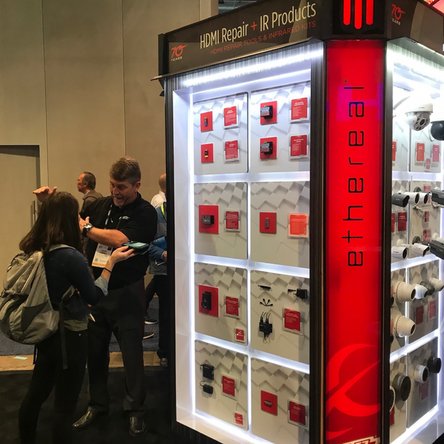I came to CES with one mission: find repairable products that solve real-world problems. I’ve covered CES before, so I knew what I was in for—but with nearly 30,000 products launching this year, I didn’t expect this to be mission impossible. It seemed like none of the attending manufacturers shared our values of repairability and practicality.
After a couple of hours wandering the show floor with no luck, I was starting to feel defeated. And then I saw it: a single booth with “repair” blazened brightly on the side of its kiosk. Success!
The company was Metra Home Theater Group. Metra has been around for 70 years and made their mark manufacturing installation accessories for home theater integration. Now they’ve got a whole slew of products and brands in their portfolio, ranging from surveillance systems to TV mounts. Their newest brand, Ethereal, is an entire line of diagnostic and repair tools that enable their technicians to pinpoint failures and repair complex home theater systems.
But what I found most interesting about Metra was their approach to product design: Their technical support team is their product engineering team. Jason Lundell, their Regional Sales Manager, told me that “each of the products [in their Ethereal line] were created to solve the issues that their tech support team heard from customers every day.” That makes a lot of sense—and a customer-first approach is arguably a better way to solve real-world problems than innovating for innovation’s sake.
When Jeff Bezos was building his empire, he required his managers—and even himself—to field customer service calls. Because only by spending time on the frontline can companies really understand how systems and processes relate to customers, and consequently design for the best experience. That’s a simple lesson that seems to be lost on today’s tech manufacturers, or at least that’s the sense I’ve gotten from attending CES for the past few years.
Companies exist to solve customer’s needs. If you’re not focused on those needs, then your business will struggle. And that’s exactly what I saw at CES—a crowded marketplace filled with companies desperate to stay relevant. As a result, the overwhelming consensus reported that CES didn’t have any new and innovative products to make noise about this year.
https://twitter.com/dlberes/status/1083440282144784384
And as more and more manufacturers continue to develop for their own ecosystems, they’re leaving the onus on their own customers to troubleshoot connectivity issues. (The dongle struggle is real, yo.) As Jason reports, “There are a lot of discrepancies between display manufacturers and their video players. And while a lot of it comes down to voltage, it could really be anything.”
So while manufacturers continue to prioritize connecting everything to the internet, there aren’t a lot of them who seem to be concerned with making it easier to connect devices to other devices. That’s a problem—because when products don’t play nice with other products, consumers have to buy more dongles, or upgrade their tech earlier than they want to when something doesn’t work. That’s a one-way street to e-waste town. Moreover, there’s no customer service for getting products to work well with one another, so when there are failures, consumers don’t have anywhere to go for support.
Metra’s at the forefront of solving that problem, and as they’ve self-reported, they’re about the only ones in the market making products to troubleshoot and repair HDMI. “[Our technician] will pinpoint and fix the problem,” Jason told us. “You can leave the integrator plugged in on the source or display side and it will just fix the issue.”
Kudos, Metra, you’ve checked all my boxes.
Mission accomplished.






0 Комментариев